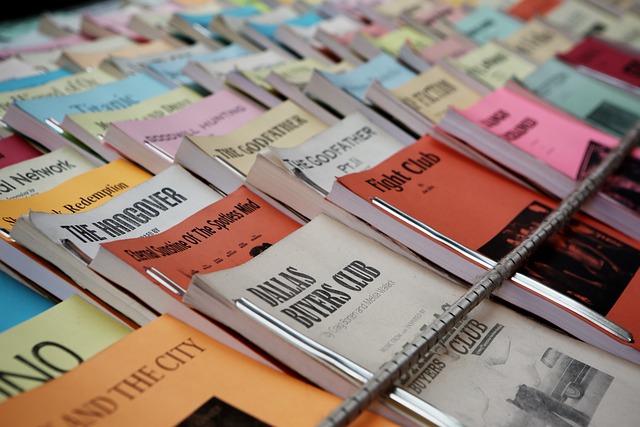Are you a cinephile with a penchant for putting your thoughts on paper? We’ve all been there, staring at that blank page, wondering whether to underline the title of that breathtaking movie you can’t wait to discuss. Do you underline a movie title when writing a paper? Best practices vary, but fear not, as we delve into the nuances of academic writing to uncover the most reliable and up-to-date guidelines. So grab your popcorn, sit back, and embark on this cinematic journey of learning.
Contents
- 1. The Importance of Properly Formatting Movie Titles in Academic Writing
- 2. Highlighting the Correct Format: To Underline or Not to Underline Movie Titles
- 3. Modern Guidelines: The Shift from Underlining to Italics in Movie Titles
- 4. Consistency Matters: Capitalization Rules for Movie Titles in Papers
- 5. Citing Movies in the Digital Age: Quotation Marks or Italics?
- 6. Expert Tips: Navigating Exceptions and Specific Cases in Movie Title Formatting
- 7. Maintaining Clarity and Coherence: Integrating Movie Titles into Your Paper
- 8. A Step-by-Step Guide: Ensuring Accuracy When Referencing Movie Titles in Academic Writing
- Frequently Asked Questions
- Future Outlook
1. The Importance of Properly Formatting Movie Titles in Academic Writing
In academic writing, it is crucial to understand the importance of properly formatting movie titles. The correct formatting not only adds professionalism to your work but also helps convey the intended meaning effectively. Here are some key reasons why adhering to proper formatting guidelines is essential for academic success:
1. Consistency: Properly formatting movie titles ensures consistency throughout your writing. By following the established formatting rules, such as italicizing or underlining movie titles, you maintain a cohesive and organized presentation. Consistency is particularly vital when referencing multiple movies within the same paper to avoid confusion among readers and to showcase your attention to detail.
2. Clarity and Impression: Correctly formatting movie titles helps create a clear and impactful impression on your readers. Italicizing or using quotation marks appropriately distinguishes movie titles from surrounding text, making them stand out and aiding in better comprehension. Remember that formatting choices can influence a reader’s perception of your work, so it’s important to make a polished and professional impression by adhering to the designated guidelines.
2. Highlighting the Correct Format: To Underline or Not to Underline Movie Titles
When it comes to writing movie titles, the correct format is an essential aspect that can often cause confusion. So, underline or not to underline? Let’s shed some light on this dilemma and highlight the correct format for movie titles.
Firstly, it’s important to note that the rules for formatting movie titles have evolved over time. Traditionally, underlining was used to signify the title of a movie. However, with the rise of technology and digital platforms, the usage of underlining has become outdated. In today’s modern writing conventions, it is recommended to use italics instead of underlining when referencing a movie title. For example, the film “Inception” should be written as Inception. This change allows for clear and consistent formatting across various mediums, whether it be print or digital.
Furthermore, it’s crucial to accurately punctuate movie titles. Consider using quotation marks for shorter works, such as episodes within a television series or short films. For instance, in the TV show “Friends,” the episode titled “The One with the Embryos” would be written as “The One with the Embryos”. On the other hand, for full-length movies, italicization is the preferred formatting style. So if you’re discussing “The Shawshank Redemption,” make sure to write it as The Shawshank Redemption. This adherence to proper formatting not only adds professionalism to your writing but also makes it easier for readers to identify and locate the movie titles you refer to.
In conclusion, when it comes to formatting movie titles in your writing, it’s crucial to stay up-to-date with the conventions that have emerged in the digital age. Rather than underlining, use italics to denote movie titles for clarity and consistency. Remember to utilize quotation marks for shorter works and adhere to correct punctuation guidelines. By following these formatting rules, you will enhance the readability and professionalism of your writing, ensuring that your movie titles stand out in all the right ways.
3. Modern Guidelines: The Shift from Underlining to Italics in Movie Titles
In the ever-evolving landscape of movie titles typography, a notable shift has occurred from the traditional practice of underlining to the more contemporary approach of using italics. This modern guideline brings a fresh aesthetic appeal to movie titles and enhances their visual impact. Here are some reasons why this shift has gained traction among filmmakers and designers:
1. Visual Cohesion: Italics offer a sleek and uniform look across different mediums, such as posters, trailers, and online promotional materials. By utilizing consistent italics for movie titles, the overall design appears more polished and cohesive, catching the viewer’s eye effortlessly.
2. Improved Readability: Underlined text often suffers from readability issues, as the solid line may cause some letters to appear crowded or distorted. In contrast, italics maintain the integrity of each character, encouraging readability even in small sizes or from a distance. Bold and italicized elements further emphasize specific words or phrases within a movie title, conveying the intended message more effectively.
4. Consistency Matters: Capitalization Rules for Movie Titles in Papers
Movie titles are an essential part of any academic paper that discusses cinema, and getting their capitalization right is crucial. Consistency in capitalizing movie titles not only reflects a strong attention to detail but also helps create a polished and professional paper. To ensure accuracy, here are some useful guidelines to follow:
1. **Capitalizing Principal Words**: In movie titles, capitalize all the principal words, including nouns, pronouns, verbs, adjectives, and adverbs. For instance, in the title “Gone with the Wind,” both “Gone” and “Wind” are capitalized as they are nouns, while “with” and “the” are not capitalized as they are articles.
2. **Exceptions to Principal Words Rule**: Articles (like “a,” “an,” and “the”), conjunctions (like “and,” “but,” and “or”), and short prepositions (such as “in,” “on,” and “at”) are not capitalized, unless they appear as the first or last word in the title. For example, “The Lord of the Rings” follows this rule, capitalizing “The” as it is the first word, whereas “of” is not capitalized.
3. **Capitalizing Important Words**: Certain words, such as the first and last words of a title, as well as adverbs, conjunctions, and prepositions longer than three letters, are usually capitalized. For instance, “To Kill a Mockingbird” capitalizes “To,” “a,” and “Mockingbird,” while “Kill” is capitalized as the first word.
4. **Other Stylistic Considerations**: Titles of movies that are an amalgamation of smaller works, such as a trilogy or series, usually capitalize all important words. In addition, movie titles that are adaptations of books or plays often follow the same capitalization as their literary counterparts.
By adhering to these capitalization rules for movie titles, your academic papers will maintain a consistent and professional tone throughout, ensuring you impress your readers with your attention to detail and accuracy. Remember to consult style guides or the specific guidelines provided by your instructor for any variations or exceptions related to capitalization rules.
5. Citing Movies in the Digital Age: Quotation Marks or Italics?
With the rise of digital platforms and streaming services, citing movies in written works has become a common task. But how should movie titles be formatted? Should they be enclosed in quotation marks or italics? Let’s explore the guidelines to help you correctly cite movies in the digital age.
When it comes to citing movies, the general rule of thumb is to use italics. Italicizing movie titles helps to differentiate them from the surrounding text and adds emphasis to the title. However, it’s important to note that certain platforms or styles, such as social media or handwritten works, may not allow for the use of italics. In such cases, you can utilize quotation marks instead. Regardless of your chosen method, consistency is key throughout your work.
Here are some useful tips to consider when citing movie titles in different scenarios:
– For academic or scholarly papers: Follow the guidelines provided by your institution or the formatting style you are using (e.g., APA, MLA). Generally, movies titles should be italicized in these contexts.
– In social media or informal writing: Quotation marks can be a practical alternative, especially when italics are not available. This method allows for easier readability in digital platforms.
– Handwritten works or on physical media: Quotation marks are often used as italics may not be feasible. Ensure that the quotation marks are clear and easily distinguishable from the rest of the text.
Remember, the primary goal of citing movies is to properly attribute the work and provide accurate references. So, whether you choose italics or quotation marks, just make sure to consistently adhere to your chosen formatting style to maintain clarity and professionalism in your writing.
Navigating exceptions and specific cases in movie title formatting can be tricky, as there are certain situations that require special attention. Here are some expert tips to help you tackle these challenges effectively:
1. Foreign language titles: When dealing with movie titles in foreign languages, it is important to follow a consistent approach. Include the original title in italics, followed by the translated title in parentheses. For instance, Le Fabuleux Destin d’Amélie Poulain (Amélie) allows the audience to recognize the film by its original French title, while also providing the English translation.
2. Sequels and prequels: When there are multiple movies in a series, it’s important to maintain consistency in formatting. If the first movie includes a subtitle, it is advisable to include the same subtitle in subsequent titles to avoid confusion. Additionally, it is best to use Roman numerals to indicate the movie’s order, like Harry Potter and the Sorcerer’s Stone (Harry Potter I), Harry Potter and the Chamber of Secrets (Harry Potter II), and so on. This helps audiences easily identify the sequence of movies.
Remember, adhering to these guidelines ensures clarity and consistency in movie title formatting, enabling your audience to understand and relate to the content effortlessly.
7. Maintaining Clarity and Coherence: Integrating Movie Titles into Your Paper
Movies are not only a form of entertainment, but they can also serve as valuable sources of information and inspiration for academic papers. However, integrating movie titles into your paper requires careful consideration to maintain clarity and coherence. Here are some tips to effectively incorporate movie titles into your writing:
1. Formatting: When mentioning a movie title in the text, it should be italicized to distinguish it from the surrounding text. For example, rather than writing “The movie ‘Inception’ discusses the concept of dreams,” it would be more appropriate to write “The movie *Inception* discusses the concept of dreams.”
2. Punctuation: It is crucial to punctuate movie titles correctly to ensure proper readability. Use quotation marks for referencing specific scenes or dialogues within the movie. For instance, “In the opening scene of *The Shawshank Redemption*, Andy Dufresne famously says, ‘Get busy living or get busy dying.'”
3. Capitalization: Movie titles should follow standard capitalization rules. Capitalize the principal words in the title, such as nouns, verbs, adjectives, and adverbs. However, do not capitalize articles, prepositions, or coordinating conjunctions unless they are the first or last words in the title. For instance, “The film *Eternal Sunshine of the Spotless Mind* explores the complexities of memory and love.”
4. Referencing multiple movies: If you are referring to multiple movies in your paper, make sure to provide clarity by using appropriate techniques, such as bullet points or a numbered list. For example:
– *Avatar*
– *The Godfather*
– *Pulp Fiction*
By following these guidelines, you can seamlessly incorporate movie titles into your academic paper, ensuring that your work remains clear and coherent. Remember to be consistent in your formatting and references throughout the paper. Happy writing and enjoy exploring the world of cinema in your scholarly pursuits!
8. A Step-by-Step Guide: Ensuring Accuracy When Referencing Movie Titles in Academic Writing
Accurately referencing movie titles in academic writing is crucial in maintaining the credibility and professionalism of your work. To ensure accuracy, it is important to follow a step-by-step guide that highlights key considerations and provides useful tips. Here, we present an easy-to-follow process to help you navigate the intricacies of referencing movie titles in your scholarly writing.
1. Formatting: When referencing movie titles, it is essential to use proper formatting. In your academic work, movie titles should be italicized, so make sure to include italics when mentioning a movie title in the text. For example: The Shawshank Redemption is a compelling film that explores the themes of friendship and survival.
2. Capitalization: Pay attention to the capitalization of movie titles. In general, all major words in movie titles should be capitalized. However, conjunctions, prepositions, and articles that are less than four letters long should be in lowercase unless they are the first or last word in the title. For instance, A Clockwork Orange is a thought-provoking film that delves into the depths of human nature.
Frequently Asked Questions
Q: Do you underline a movie title when writing a paper?
A: No, it is not necessary to underline a movie title when writing a paper. Modern writing standards suggest using italics instead of underlining for movie titles.
Q: Why is underlining no longer considered appropriate for movie titles?
A: Underlining used to be the norm when typewriters were widely used for writing. With the advent of word processing software and the development of standardized rules, underlining has been replaced by italics for better clarity and readability.
Q: When should I use italics for movie titles in my paper?
A: Movie titles should be italicized when writing a paper to make them stand out. Italicizing helps to differentiate titles from regular text, giving them the necessary visual emphasis they deserve.
Q: Are there any exceptions to using italics for movie titles?
A: Yes, there are specific scenarios where italics are not used. For example, if you are handwriting your paper or are in a situation where italics are not available, you can underline the movie title instead. However, it is always best to abide by modern writing conventions and use italics whenever possible.
Q: Can I use quotation marks for movie titles instead of italics?
A: It is generally not recommended to use quotation marks for movie titles in academic writing. Quotation marks are more commonly used for shorter works, such as articles or chapters, while italics are preferred for longer works like movies. However, the specific guidelines may vary depending on the style guide you are following, so it’s essential to consult the appropriate style manual for your paper.
Q: What if I’m writing a handwritten paper or can’t use italics?
A: If you are writing a paper by hand or unable to utilize italics, you can underline movie titles instead. However, keep in mind that underlining is a legacy convention from the typewriter era and using italics is the generally accepted modern practice.
Q: What other formatting guidelines should I consider for movie titles in my paper?
A: In addition to using italics or underlining for movie titles, it is also important to capitalize all major words in the title, including nouns, pronouns, verbs, adjectives, and adverbs. Articles, conjunctions, and prepositions should not be capitalized unless they are the first or last words in the title. Consistency in formatting is crucial throughout your paper.
Future Outlook
In conclusion, it is best to use italics instead of underlining when writing a paper and introducing a movie title to ensure clarity and consistency.





